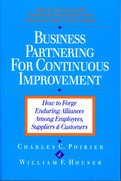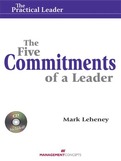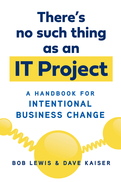If you want to make the drive for quality, productivity, and profit improvement a permanent feature of your organization, the concept of "partnering"-building alliances among employees, suppliers, and customers-must become an integral part of every activity, write Charles Poirier and William Houser. Every employee must see every other employee as a partner instead of a competitor. Similarly, every supplier and customer must be recognized as a potential ally for improvement, not just a source of goods or income. Poirier and Houser give detailed action studies of companies that have made the transition, and provide the tools to make similar changes in your own organization.
- A highly visual presentation that enables readers to see organizational dimensions in a whole new way
What really defines leadership? Our concepts of leadership are usually based on our unique personal experiences, and it is clear that a leadership style that works in one situation can be a recipe for disaster in another. In leadership, one size does not fit all.
In The Five Commitments of a Leader, Mark Leheney asserts that a more revealing way to examine leadership is through the commitments a leader makes (or fails to make). He focuses on five commitments a leader must make to be effective—commitments to:
•The self
•People
•The organization
•The truth
•Leadership
Too many businesses miss opportunity after opportunity to design, plan, and achieve intentional business change. Why? Because they charter projects focused on delivering software products: IT projects. But as this groundbreaking book points out, there's no such thing as an IT project—or at least there shouldn't be. It's always about intentional business change, or what's the point?
It's time to stop providing simplistic, one-dimensional, all-you-gotta-do panaceas. When the only constant in business is change, truly useful IT has to help you change instead of build solutions that are obsolete even before they are completed.
IT consultant Bob Lewis, author of the bestselling Bare Bones Project Management, has joined forces with seasoned CIO Dave Kaiser to give you the tools you need. It's a multidimensional, relentlessly practical guide. Condensed to handbook length and seasoned with Lewis's trademark sardonic humor, it's an enjoyable and digestible read as well.
Lewis and Kaiser take you step by step through the process of building a collaboration between IT and the rest of the business that really works. Insisting on intentional business change takes patience, communication, and courage, but it has a huge payoff. More to the point, insist on anything else and every penny you spend will be a wasted dime and a waste of time.
This is a book about taking health care the last mile-sometimes literally-to prevent widespread, unnecessary, and easily avoided death and suffering.
- Offers a creative, entrepreneurial approach to bringing lifesaving health care to those who need it most
- Features real-world examples of this approach in action around the world
- Coauthored by a prominent health-care expert and a leading business professor and copublished by the prestigious George W. Bush Institute
Every three minutes, nearly 50 children under the age of five dies. In the same three minutes, 2 mothers lose their lives in childbirth. Every year, malaria kills 655,000 people, despite the fact that it can be prevented with a mosquito net and treated for $1.41.
Sadly, this list goes on and on. Millions are dying from diseases that we can easily and inexpensively prevent, diagnose, and treat. Why? Because even though we know exactly what people need, we just can't get it to them. They are dying not because we can't solve a medical problem but because we can't solve a logistics problem.
In this profoundly important book, Eric Bing and Marc Epstein lay out a solution: a new kind of bottom-up health care that is delivered at the source. We need microclinics, micropharmacies, and microentrepreneurs located in the remote, hard-to-reach communities they serve. By building a new model that "scales down" to train and incentivize all kinds of health-care providers in their own villages and towns, we can create an army of on-site professionals who can prevent tragedy at a fraction of the cost of top-down bureaucratic programs.
Bing and Epstein have seen the model work, and they provide example after example of the extraordinary results it has achieved in Africa, Asia, and Latin America. They describe the principles and practices involved in implementing it and explain how to apply it to overcome specific health challenges.
This is a book about taking health care the last mile-sometimes literally-to prevent widespread, unnecessary, and easily avoided death and suffering. Pharmacy on a Bicycle shows how the same forces of innovation and entrepreneurship that work in first-world business cultures can be unleashed to save the lives of millions.
- Offers a creative, entrepreneurial approach to bringing lifesaving health care to those who need it most
- Features real-world examples of this approach in action around the world
- Coauthored by a prominent health-care expert and a leading business professor and copublished by the prestigious George W. Bush Institute
- Read the press release here; for media review copies contact [email protected]
Every three minutes, nearly 50 children under the age of five dies. In the same three minutes, 2 mothers lose their lives in childbirth. Every year, malaria kills 655,000 people, despite the fact that it can be prevented with a mosquito net and treated for $1.41.
Sadly, this list goes on and on. Millions are dying from diseases that we can easily and inexpensively prevent, diagnose, and treat. Why? Because even though we know exactly what people need, we just cant get it to them. They are dying not because we can't solve a medical problem but because we cant solve a logistics problem.
In this profoundly important book, Eric Bing and Marc Epstein lay out a solution: a new kind of bottom-up health care that is delivered at the source. We need microclinics, micropharmacies, and microentrepreneurs located in the remote, hard-to-reach communities they serve. By building a new model that "scales down" to train and incentivize all kinds of health-care providers in their own villages and towns, we can create an army of on-site professionals who can prevent tragedy at a fraction of the cost of top-down bureaucratic programs.
Bing and Epstein have seen the model work, and they provide example after example of the extraordinary results it has achieved in Africa, Asia, and Latin America. They describe the principles and practices involved in implementing it and explain how to apply it to overcome specific health challenges.
This is a book about taking health care the last milesometimes literallyto prevent widespread, unnecessary, and easily avoided death and suffering. Pharmacy on a Bicycle shows how the same forces of innovation and entrepreneurship that work in first-world business cultures can be unleashed to save the lives of millions.
How is it that some Human Resource Development (HRD) professionals consistently get the results that their organizations need, while others regularly get lost in the process? The Human Resource Development Research Handbook argues that expert HRD professionals think like researchers. You don't need to be a researcher to obtain consistently high-quality HRD results, but thinking like a researcher gives you the discipline required to be an expert. Thus, the much-hyped gap between theory and practice is the arena of opportunity and excellence. The Human Resource Development Research Handbook gives practitioners the tools they need to stay on the leading edge of the profession. It addresses three core areas: The practical importance of research; ways of doing practical research; and getting started on research. Written for practitioners and scholars, this is the first book to explain the value, purposes, methods, and processes of HRD research in clear, simple language.
The Human Resource Development Research Handbook demystifies the research process so HRD practitioners can transform their practice to incorporate leading-edge research. Each chapter is written in straightforward language by a leading researcher. Real-world examples clearly show how research and theory are not just for academics, but are practical tools to solve everyday problems.
- Written by top researchers in the field of Human Resource Development
- Uses real-world examples to make the research understandable
- Helps practitioners solve complex practical problems that need the application of existing or new research
- Sponsored by the Academy of Human Resource Development and the American Society for Training and Development

























